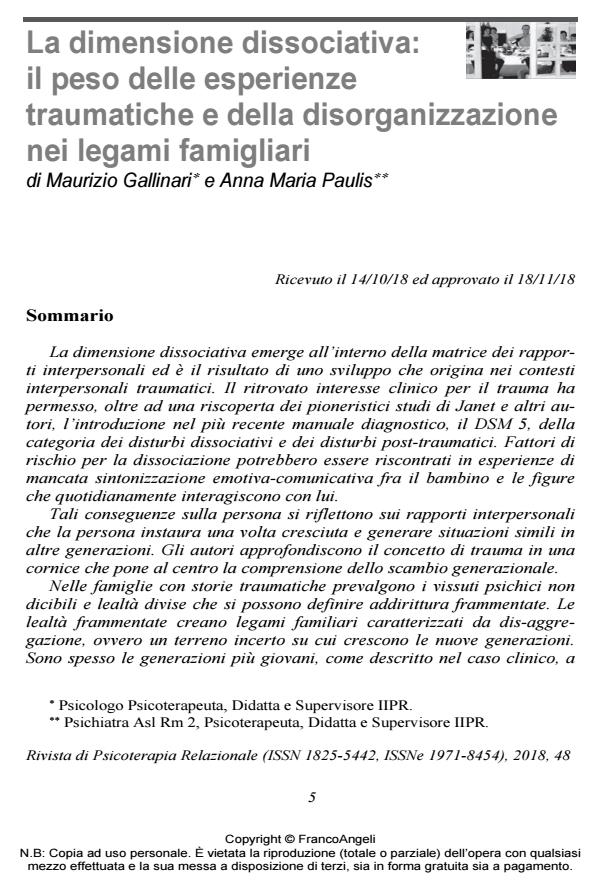La dimensione dissociativa: il peso delle esperienze traumatiche e della disorganizzazione nei legami famigliari
Journal title RIVISTA DI PSICOTERAPIA RELAZIONALE
Author/s Maurizio Gallinari, Anna Maria Paulis
Publishing Year 2019 Issue 2018/48
Language Italian Pages 49 P. 5-53 File size 533 KB
DOI 10.3280/PR2018-048001
DOI is like a bar code for intellectual property: to have more infomation
click here
Below, you can see the article first page
If you want to buy this article in PDF format, you can do it, following the instructions to buy download credits

FrancoAngeli is member of Publishers International Linking Association, Inc (PILA), a not-for-profit association which run the CrossRef service enabling links to and from online scholarly content.
The dissociative dimension emerges within the matrix of interpersonal relationships and is the result of a development that originates in traumatic interpersonal contexts. The rediscovered clinical interest in the trauma has allowed, in addition to a rediscovery of the pioneering studies by Janet and other authors, the introduction in the most recent diagnostic manual, the DSM 5, of the category of dissociative disorders and post-traumatic disorders. Risk factors for dissociation could be found in experiences of lack of emotional-communicative tuning between the child and the figures who daily interact with him. These consequences on the person are reflected on the interpersonal relationships that the person establishes once grown and generate similar situations in other generations. The autors deepen the concept of trauma in a framework that focuses on the understanding of generational interchange. In families with traumatic histories, non-speakable psychic experiences and divided loyalties prevail and can even be defined as fragmented. Fragmented loyalties create family bonds characterized by dis-aggre¬ga¬tion, that is an uncertain terrain on which new generations grow. It is often the younger generations, as described in clinical case, who pay the highest price, especially in terms of the relational context in which they are born.
Keywords: Dissociation, dis-aggregation, trauma, generational inter-change, invisible loyalty, fragmented loyalties.
- Ombre: le vuote presenze del neglect genitoriale tra assenza di riparazioni e conflitti di lealtà Chiara Bastianoni, in RIVISTA DI PSICOTERAPIA RELAZIONALE 61/2025 pp.41
DOI: 10.3280/PR2025-061003
Maurizio Gallinari, Anna Maria Paulis, La dimensione dissociativa: il peso delle esperienze traumatiche e della disorganizzazione nei legami famigliari in "RIVISTA DI PSICOTERAPIA RELAZIONALE " 48/2018, pp 5-53, DOI: 10.3280/PR2018-048001